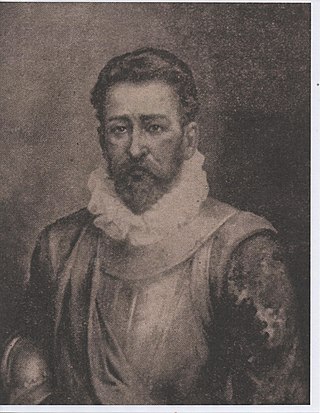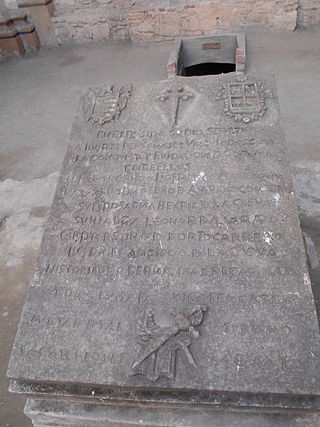Related Research Articles

Pedro de Alvarado was a Spanish conquistador and governor of Guatemala. He participated in the conquest of Cuba, in Juan de Grijalva's exploration of the coasts of the Yucatán Peninsula and the Gulf of Mexico, and in the conquest of the Aztec Empire led by Hernán Cortés. He is considered the conquistador of much of Central America, including Guatemala, Honduras, El Salvador, and parts of Nicaragua.

Tecun Uman was one of the last rulers of the K'iche' Maya people, in the Highlands of what is now Guatemala. According to the Kaqchikel annals, he was slain by Spanish conquistador Pedro de Alvarado while waging battle against the Spanish and their allies on the approach to Quetzaltenango on 12 February 1524. Tecun Uman was declared Guatemala's official national hero on March 22, 1960, and is commemorated on February 20, the popular anniversary of his death. Tecun Uman has inspired a wide variety of activities ranging from the production of statues and poetry to the retelling of the legend in the form of folkloric dances to prayers. Despite this, Tecun Uman's existence is not well documented, and it has proven to be difficult to separate the man from the legend.

In a protracted conflict during the Spanish colonization of the Americas, Spanish colonisers gradually incorporated the territory that became the modern country of Guatemala into the colonial Viceroyalty of New Spain. Before the conquest, this territory contained a number of competing Mesoamerican kingdoms, the majority of which were Maya. Many conquistadors viewed the Maya as "infidels" who needed to be forcefully converted and pacified, disregarding the achievements of their civilization. The first contact between the Maya and European explorers came in the early 16th century when a Spanish ship sailing from Panama to Santo Domingo was wrecked on the east coast of the Yucatán Peninsula in 1511. Several Spanish expeditions followed in 1517 and 1519, making landfall on various parts of the Yucatán coast. The Spanish conquest of the Maya was a prolonged affair; the Maya kingdoms resisted integration into the Spanish Empire with such tenacity that their defeat took almost two centuries.

Tlaxcala was a pre-Columbian city and state in central Mexico.
Kaybʼil Bʼalam was a 16th-century leader of the Mam people in the Maya kingdom in the western highlands of Guatemala. During the time of the Spanish invasion, the Mam population was mainly situated in Xinabahul. However, due to the Spanish conquest, the people returned to the stone fortifications of Zaculeu for protection.
Matthew Restall is a historian of Colonial Latin America. He is an ethnohistorian, a Mayanist, a scholar of the conquest, colonization, and the African diaspora in the Americas, and a historian of popular music. Restall has areas of specialization in Yucatán and Mexico, Guatemala, and Belize. He is a member of the New Philology school of colonial Mexican history and the founder of a related school, the New Conquest History. He is currently Edwin Erle Sparks Professor of Latin American History and Anthropology, and Director of Latin American Studies, at the Pennsylvania State University. He is a former president of the American Society for Ethnohistory (2017–18), a former editor of Ethnohistory journal (2007–17), a former senior editor of the Hispanic American Historical Review (2017–22), editor of the book series Latin American Originals, and co-editor of the Cambridge Latin American Studies book series. He also writes books on the history of popular music.
Jorge de Alvarado y Contreras was a Spanish conquistador, brother of the more famous Pedro de Alvarado.

Juan Vázquez de Coronado y Anaya was a Spanish conquistador, remembered especially for his role in the colonization of Costa Rica, in Central America, where he gained a reputation for fairness, effective administration, and good relationships with the native population. He was a nephew of Francisco Vázquez de Coronado y Luján, who explored the southwestern United States between 1540 and 1542.

Indian auxiliaries, also known as Indios amigos, were those indigenous peoples of the Americas who allied with Spain and fought alongside the conquistadors during the Spanish colonization of the Americas. These auxiliaries acted as guides, translators and porters, and in these roles were also referred to as yanakuna, particularly during the Spanish conquest of the Inca Empire. The term was also used for formations composed of indigenous warriors which were used by the Spanish for reconnaissance and combat duties. Indian auxiliaries continued to be used by the Spanish to maintain control over their colonies in the Americas; frequently stationed on the frontier, they were often used to suppress anti-colonial revolts such as Arauco War.

The Spanish conquest of the Maya was a protracted conflict during the Spanish colonisation of the Americas, in which the Spanish conquistadores and their allies gradually incorporated the territory of the Late Postclassic Maya states and polities into the colonial Viceroyalty of New Spain. The Maya occupied the Maya Region, an area that is now part of the modern countries of Mexico, Guatemala, Belize, Honduras and El Salvador; the conquest began in the early 16th century and is generally considered to have ended in 1697.
Gonzalo de Alvarado y Chávez was a Spanish conquistador and cousin of Pedro de Alvarado and accompanied him on his first campaign in Guatemala. In 1525 he was appointed chief constable of Santiago de los Caballeros de Guatemala, the new capital. He married Isabel, a daughter of Jorge de Alvarado, his cousin. It is not known when he died.
Luis de Moscoso Alvarado (1505–1551) was a Spanish explorer and conquistador. Luis de Moscoso Alvarado assumed command of Hernando De Soto's expedition upon the latter's death.

Diego de Holguín was a Spanish conquistador and the first mayor of San Salvador, serving from 1525 to 1528. He participated in the conquest of many nations in the Caribbean islands, Central America and Mexico, where he became famous for his courage.

The Lienzo de Quauhquechollan is a 16th-century lienzo of the Nahua, a group of indigenous peoples of Mexico. It is one of two surviving Nahua pictorial records recounting the Spanish conquest of Guatemala and the earliest surviving maps of what is now Guatemala.
Alvarado was the Spanish family of conquistadors.
- Diego Gómez de Alvarado y Mexía de Sandoval. the Commander of municipalities including Lobón, Montijo and Cubillana, Alcalde of Montánchez, Trece of the Order of Santiago, Lord of Castellanos, a Maestresala official instructor of Henry IV of Castile and General of the Frontier of Portugal. 1st wife: Teresa Suárez de Moscoso y Figueroa; 2nd wife Leonor de Contreras y Gutiérrez de Trejo. His sons:
- Pedro de Alvarado, famous conquistador. 1st wife Fransisca de Cueva, 2nd - her cousin Beatriz de la Cueva. Both childless. But more so than his wives his vital companion was Luisa de Tlaxcala, an Indigenous noblewoman, daughter of the Tlaxcaltec Chief Xicotenga. With Luisa de Tlaxcala he had three children, and two more from other women
- Gonzalo de Alvarado y Contreras. His descendants were represented by the family Vides de Alvarado after the famous 17th-century historians Francisco Antonio de Fuentes y Guzmán and also the father Domingo Juarros y Montufar.
- Jorge de Alvarado. Jorge married a daughter of Xicotencatl I, the ruler of Tizatlan in Tlaxcala. She was baptized with the Spanish name doña Lucía. They had a daughter who married the conquistador Francisco Xiron Manuel and had issue. Also he married twice, firstly to Francisca Girón and secondly in 1526 to Luisa de Estrada, certainly related to Francisco Vázquez de Coronado's wife, by whom he had a son Jorge de Alvarado y Estrada, born in México, who married Catalina de Villafañe y Carvajal, Mexican, daughter of Ángel de Villafañe, conqueror of Mexico, and wife Inés de Carvajal. Their son was Jorge de Alvarado y Villafañe, also born in Mexico, Governor and Captain-General of Honduras and Knight of Santiago since 1587, also married twice, firstly to Brianda de Quiñones and secondly to Juana de Benavides, vecina of Guatemala, and had issue.
- and Gómez, Hernando and Juan.
The Spanish conquest of Chiapas was the campaign undertaken by the Spanish conquistadores against the Late Postclassic Mesoamerican polities in the territory that is now incorporated into the modern Mexican state of Chiapas. The region is physically diverse, featuring a number of highland areas, including the Sierra Madre de Chiapas and the Montañas Centrales, a southern littoral plain known as Soconusco and a central depression formed by the drainage of the Grijalva River.

The Spanish conquest of Honduras was a 16th-century conflict during the Spanish colonization of the Americas in which the territory that now comprises the Republic of Honduras, one of the seven states of Central America, was incorporated into the Spanish Empire. In 1502, the territory was claimed for the king of Spain by Christopher Columbus on his fourth and final trip to the New World. The territory that now comprises Honduras was inhabited by a mix of indigenous peoples straddling a transitional cultural zone between Mesoamerica to the northwest, and the Intermediate Area to the southeast. Indigenous groups included Maya, Lenca, Pech, Miskitu, Mayangna (Sumu), Jicaque, Pipil and Chorotega. Two indigenous leaders are particularly notable for their resistance against the Spanish; the Maya leader Sicumba, and the Lenca ruler referred to as Lempira.

Pedro de Portocarrero was a Spanish conquistador who was active in the early 16th century in Guatemala, and Chiapas in southern Mexico. He was one of the few Spanish noblemen that took part in the early stages of the Spanish conquest of the Americas, and was distantly related to prominent conquistador Pedro de Alvarado, who appointed him as an official in early colonial Guatemala.

The Spanish conquest of El Salvador was the campaign undertaken by the Spanish conquistadores against the Late Postclassic Mesoamerican polities in the territory that is now incorporated into the modern Central American country of El Salvador. El Salvador is the smallest country in Central America, and is dominated by two mountain ranges running east–west. Its climate is tropical, and the year is divided into wet and dry seasons. Before the conquest the country formed a part of the Mesoamerican cultural region, and was inhabited by a number of indigenous peoples, including the Pipil, the Lenca, the Xinca, and Maya. Native weaponry consisted of spears, bows and arrows, and wooden swords with inset stone blades; they wore padded cotton armour.
Gómez de Alvarado y Contreras was a Spanish conquistador and explorer. He was a member of the Alvarado family and the older brother of the famous conquistador Pedro de Alvarado.
References
- ↑ "Conquered Conquistadors" Florine G.L. Asselbergs, First Edition, published 2004